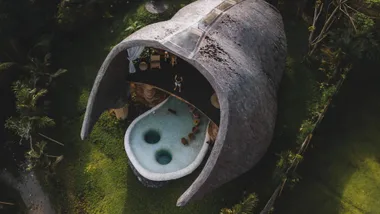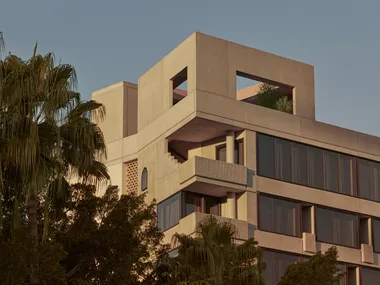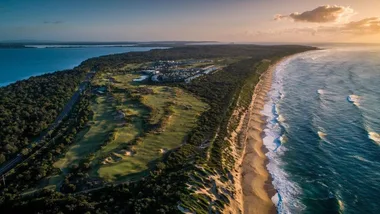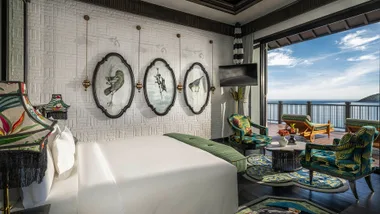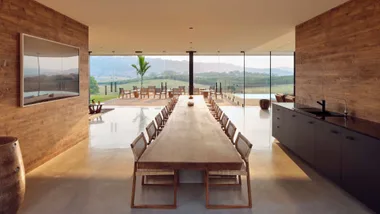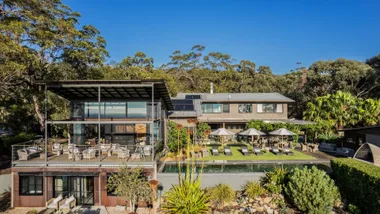The Welsh countryside is littered with places named after fairies, dragons and the battles of Arthurian knights. The legends live on, too, in a collection of luxe cabins that popped up like magic this northern summer in remote spots in Snowdonia and the Llyn Peninsula.
Inspired by folklore and the global tiny-house movement, the eight artfully designed pods, collectively known as the Epic Retreats, are the result of a global competition staged to promote Wales’ 2017 Year of Legends. The anonymous entries were required to use Welsh building materials, meet restrictions on size, weight, and cost (a maximum budget of £11,000) and include features not usually seen on camping trips: an ensuite shower, a double, king or circular bed, a composting toilet, and a seating area with wood-burning stove.

Inside Dragon’s Eye
The results are as colourful as Welsh history. The Dragon’s Eye is an unblinking glass and steel-scaled ocular wonder by Welsh-born tiny-house proponent Carwyn Lloyd Jones. Arthur’s Cave, based on the story of a royal refuge that vanished after a single night, is a suitably dark and moody portal with undulating walls and ceiling. There’s the Black Hat, based on the shape of a traditional Welsh stovepipe hat, and Skyhut, equipped with retractable walls and ceiling and a telescope for stargazing; it pays homage to the myth of Cadair Idris, a Welsh mountain on which it was said that travellers who slept under the stars would awaken as madmen or poets.

The dark and moody Arthur’s Cave
The Miner’s Legend requires guests to crawl through a small tunnel to enter, while the elevated Animated Forest, based on the medieval Welsh poem Cad Goddeau, or The Battle of the Trees, has a circular door that rolls across the entrance like a boulder blocking a cave. The Little Dragon pod even manages to fit two levels into its tiny circular structure as well as a door decorated with intricate Celtic knotwork.

Animated Forest has a boulder-like door that rolls across the entrance.
Epic Retreats has an Australian connection, too. Slate Cabin is the work of new Sydney architecture studio Trias, which is attracting international attention for its groundbreaking work that upholds the mantra of “less but better”. Trias principal and founder Jennifer McMaster says slate, used commonly throughout Wales, was the key inspiration. “Slate really appealed to us because it’s textured, heavy, rough and dark,” she says. “When you’re in Wales you see a lot of new buildings are clad in slate and a lot of older farms have walls made with dry slate.”

Slate Cabin by Sydney firm Trias
McMaster describes Slate Cabin as “an introverted space, solid but escapist”. “It’s solid and impenetrable on the outside but warm and light and connected to the landscape. The building is all about the framing of the views.” The structure has external battens between which guests can stack pieces of slate, changing the cabin’s appearance at whim. The interiors, in birch plywood, provide a light, warm contrast to the sombre exterior and the clever use of space, including a table for two and the bed on a raised platform, evoke the feeling of a landlocked yacht.

Slate Cabin’s plywood interiors
The eight flights of fancy have sparked a Grand Designs-esque television series, Cabins in the Wild, and become a tourist attraction in themselves. “The whole concept really delivers the full Welsh experience,” says Cambria Tours managing director and Epic Retreats partner Aled Rees. “They deliver the history and landscape in one package.”
The pods, built for two, are positioned for privacy and within walking distance of a communal area where guests can share meals and storytelling around a campfire. Priced from £425 for a weekend package, the pods have been heavily booked during their first season. They disappear from the rolling green Welsh countryside at the end of their summer residency and will reappear next year, though Rees said it’s yet to be decided if they’ll remain together on one site or sprinkled throughout wild Wales.


